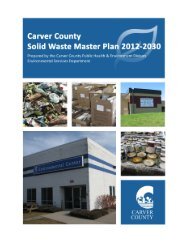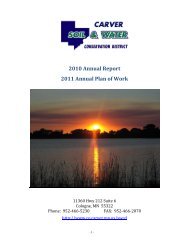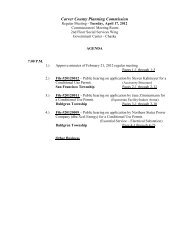Unintended Pregnancy - Carver County
Unintended Pregnancy - Carver County
Unintended Pregnancy - Carver County
You also want an ePaper? Increase the reach of your titles
YUMPU automatically turns print PDFs into web optimized ePapers that Google loves.
<strong>Unintended</strong> <strong>Pregnancy</strong><br />
Problem:<br />
Goal:<br />
<strong>Unintended</strong> pregnancy increases the risk for poor maternal and infant health outcomes,<br />
economic stress and emotional stress among <strong>Carver</strong> <strong>County</strong> residents.<br />
Reduce unintended pregnancy.<br />
An unintended pregnancy is one defined by the mother as<br />
being either unwanted or mistimed at the time of conception.<br />
About half of all pregnancies in the U.S. are unintended,<br />
according to the Alan Guttmacher Institute. 1<br />
The consequences of unintended pregnancy can be serious for<br />
the health of the woman and the infant. The Minnesota<br />
Department of Health (MDH) reports that women who have<br />
unintended pregnancies are less likely to engage in healthy<br />
behaviors during the pregnancy, such as early prenatal care,<br />
good nutrition and avoidance of alcohol, tobacco and other<br />
drugs. Their babies are more likely to be low birth weight and<br />
less likely to be breastfed. The parents are less likely to be<br />
educationally and vocationally prepared to financially support<br />
the child, so there is an increased risk of welfare dependency<br />
and poverty. Domestic violence and divorce are more common<br />
among couples that have an unintended pregnancy. The<br />
children of unintended pregnancies are more likely to be raised<br />
by one parent and are more likely to become teen parents<br />
themselves. 2<br />
The Minnesota Department of Human Services estimates $108<br />
million a year is spent for delivery and first-year costs<br />
associated with publicly funded births resulting from<br />
unintended pregnancies. Millions more is spent each year to<br />
provide public assistance to support the children of unintended<br />
pregnancies. 3 For every dollar spent on family planning<br />
services, three dollars is saved in Medicaid costs in the first<br />
year of a prevented pregnancy, according to the Minnesota<br />
Statewide Association for Family Planning. 3<br />
Those considered at risk for unintended pregnancy are sexually<br />
active, fertile women who are not intentionally pregnant or<br />
trying to get pregnant. <strong>Carver</strong> <strong>County</strong> has a significant percent<br />
of its population in that category. According to the 2000 Alan<br />
Guttmacher Institute data, <strong>Carver</strong> <strong>County</strong> has approximately<br />
8,640 women, ages of 13-44, who need contraceptive services<br />
and supplies (approximately 50 percent of all women in that<br />
age group). 4 It can be estimated that an equal number of male<br />
partners are in need of family planning services for the<br />
prevention of unintended pregnancies and the spread of<br />
sexually transmitted diseases.<br />
The relatively high number of men and women of childbearing<br />
age who reside in <strong>Carver</strong> <strong>County</strong> is reflected in the county’s<br />
high pregnancy, fertility and birth rates. <strong>County</strong> rates in all<br />
three areas are higher than the rates for Minnesota. 5<br />
CARVER COUNTY COMMUNITY HEALTH SERVICES/PUBLIC HEALTH -107- 2004-2008 ASSESSMENT
Table 10.1 compares pregnancy rates, abortion rates, fertility rates, birth rates and the number of live births for <strong>Carver</strong> <strong>County</strong> and<br />
Minnesota. 6 The pregnancy rate is the number of pregnancies per 1,000 women in the population age 15-44. The abortion rate is the<br />
number of abortions per 1,000 women in the population age 15-44. The fertility rate is the number of live births per 1,000 women in<br />
the population age 15-44. The birth rate is the number of live births per 1,000 population.<br />
Table 10.1: Natality Statistics for <strong>Carver</strong> <strong>County</strong> and Minnesota<br />
<strong>Carver</strong> <strong>County</strong> Natality Statistics 1991 1993 1995 1997 1999 2000 2001<br />
Source: Minnesota Department of Health, 2002 <strong>County</strong> Health Tables.<br />
Minnesota<br />
2001<br />
<strong>Pregnancy</strong> Rate 87.2 83.0 82.2 80.2 78.0 77.5 81.1 74.0<br />
Abortion Rate<br />
Fertility Rate<br />
Birth Rate<br />
12.2 9.9 8.4 9.5 7.0 6.8 7.9 12.3<br />
74.6 72.9 73.8 70.5 71.0 70.5 72.7 61.3<br />
18.1 17.7 17.3 16.3 16.0 16.2 16.9 13.5<br />
Number of Live Births 891 932 987 1,029 1,086 1,140 1,183 66,620<br />
<strong>Pregnancy</strong> Rate: The number of pregnancies per 1,000 women in the population of age 15 through 44.<br />
Abortion Rate: The number of abortions per 1,000 women in the population of age 15 through 44. The abortion rate includes both therapeutic and spontaneous abortions.<br />
Fertility Rate: The number of live births per 1,000 women in the population of age 15-44 years.<br />
Birth Rate: The number of live births per 1,000 population.<br />
The 2001 pregnancy rate for <strong>Carver</strong> <strong>County</strong> (the number of<br />
pregnancies per 1,000 women age 15-44) is 81.1, which is<br />
higher than the state pregnancy rate of 74.0.The 2001 fertility<br />
rate, or the number of live births per 1,000 women ages 15-44,<br />
was 72.7 for <strong>Carver</strong> <strong>County</strong> compared to 61.3 for the state. 6<br />
The 2001 birth rate for the county is 16.9, which is higher than<br />
the state rate of 13.5. The birth rate for <strong>Carver</strong> <strong>County</strong><br />
decreased from 18.1 in 1991 to 16.9 in 2001, but the actual<br />
number of births increased from 891 to 1,183 during that time<br />
period. 6<br />
The Alan Guttmacher Institute reports that about half of all<br />
unintended pregnancies in the U.S. end in abortion. 1 It is<br />
estimated that 46 percent of pregnancies in Minnesota are<br />
unintended and half of those end in abortion, according to the<br />
preliminary data from the Behavioral Risk Factor Survey<br />
conducted in Minnesota. 7 The abortion rate in <strong>Carver</strong> <strong>County</strong><br />
(the number of induced abortions per 1,000 women in the<br />
population of age 15-44) was 7.9 in 2001. That is lower than<br />
the state abortion rate of 12.3. There were 13,447 abortions in<br />
Minnesota in 2001, and 128 in <strong>Carver</strong> <strong>County</strong>. 6<br />
For the past 10 years, <strong>Carver</strong> <strong>County</strong> Community Health<br />
Services has received a Family Planning Special Projects grant<br />
from the Minnesota Department of Health to help provide<br />
services to prevent unintended pregnancies among county<br />
residents. CCCHS received notice in December of 2003 that it<br />
CARVER COUNTY COMMUNITY HEALTH SERVICES/PUBLIC HEALTH -108- 2004-2008 ASSESSMENT
will not receive grant funding for family planning programs in<br />
2004 due to budget cuts at the state level. Therefore, CCCHS<br />
will be working with other community members to connect<br />
clients to other low-cost family planning resources.<br />
Minnesota’s family planning funds, including those received<br />
by <strong>Carver</strong> <strong>County</strong> Community Health Services, have never<br />
been used to counsel towards or provide abortion services.<br />
The CCCHS Family Planning Program and Maternal and Child<br />
Health Program have helped families:<br />
• Avoid unintended pregnancy and abortion<br />
• Take advantage of pre-pregnancy risk identification and<br />
management and initiate needed changes in diet,<br />
exercise, smoking, drinking and toxic exposure<br />
• Receive services such as counseling, screening and<br />
prevention programs that promote emotional, mental<br />
and physical health, as well as social responsibility<br />
• Time the additions to their families when their health,<br />
financial conditions and personal situation are optimal,<br />
and they are prepared to provide the support and care<br />
needed to all children to reach their full potential.<br />
Women Most At Risk for <strong>Unintended</strong> <strong>Pregnancy</strong><br />
Within the at-risk for unintended pregnancy population,<br />
women living in poverty and women of color have a history of<br />
being at a greater risk for unintended pregnancy and poor birth<br />
outcomes, according to a Minnesota Department of Health<br />
report. 9<br />
A report by Family Planning Perspectives found that 61<br />
percent of the pregnancies to women living below Federal<br />
Poverty Guidelines, and 53 percent of the pregnancies of<br />
women living between 100 and 199 percent of poverty, are<br />
unintended. 9 In <strong>Carver</strong> <strong>County</strong>, 3.5 percent of the population<br />
lives below 100 percent of poverty, and 12 percent lives below<br />
200 percent of poverty. 10<br />
The Alan Guttmacher Institute estimates that women living<br />
below 200 percent of poverty make up 20 percent of the total<br />
number of women at risk for unintended pregnancy. The<br />
Minnesota Department of Health has used the Alan Guttmacher<br />
Institute’s 1995 data to estimate there are 1,628 <strong>Carver</strong> <strong>County</strong><br />
women who are low income (living at below 200 percent of<br />
poverty) and at risk for unintended pregnancy. Included in this<br />
group are women who have no insurance or are under-insured<br />
in the sense that their insurance policies do not cover the cost<br />
of family planning exams and/or contraceptive services and<br />
supplies. 4<br />
Approximately 8.3 percent of women from <strong>Carver</strong> <strong>County</strong> who<br />
delivered babies in 2001 were women of color; 91.7 percent<br />
were white, non-Hispanic/Latino origin, and 4.8 percent were<br />
Hispanic. 10 <strong>Carver</strong> <strong>County</strong> Community Health Services<br />
(CCCHS) is aware of the increasingly diverse county<br />
population and the need to provide services that are culturally<br />
and linguistically appropriate for those populations. In 2001, 22<br />
percent of the women who received family planning services<br />
from CCCHS were non-white and 19 percent were Hispanic. 11<br />
The Family Planning Perspectives 1998 report also found that<br />
72 percent of pregnancies to African Americans and 48 percent<br />
of pregnancies to Hispanics were unintended. 9<br />
CCCHS has focused its efforts on providing pre-pregnancy<br />
family planning services on the populations most at risk for<br />
unintended pregnancies. In 2002, county public health nurses<br />
provided home visits through the Maternal Child Health Grant<br />
CARVER COUNTY COMMUNITY HEALTH SERVICES/PUBLIC HEALTH -109- 2004-2008 ASSESSMENT
to 82 women to discuss pregnancy prevention. Education on<br />
sexuality and reproductive health topics was provided to 3,674<br />
individuals in 570 group settings. Through the Family Planning<br />
Services program, 82 clients received education to prevent<br />
unintended pregnancy and a portion of those received low-cost<br />
birth control methods. 11<br />
Out-of-Wedlock Births<br />
Unmarried women and teen-agers who are within the<br />
population of women at-risk for unintended pregnancies face a<br />
greater risk of unintended pregnancies and poor health<br />
outcomes related to those pregnancies.<br />
While 31 percent of the pregnancies to married women in the<br />
U.S. are unintended, 77 percent of pregnancies to women who<br />
have never married are unintended, according to an Alan<br />
Guttmacher Institute report. 11 Table 10.2 compares the<br />
percentage of births to unmarried mothers for <strong>Carver</strong> <strong>County</strong><br />
with the percentage for Minnesota. 6<br />
Table 10.2 2001 Out-of-Wedlock Births <strong>Carver</strong> <strong>County</strong>/Minnesota<br />
Out-of Wedlock Births<br />
Population<br />
<strong>Carver</strong><br />
<strong>County</strong><br />
2001<br />
Minnesota<br />
2001<br />
70,205 4,919,479<br />
% Births to Unmarried Mothers 11.2 25.8<br />
Source: Minnesota Department of Health, 2002 <strong>County</strong> Health Tables.<br />
The percentage of births to single, unmarried women in <strong>Carver</strong><br />
<strong>County</strong> in 2001 was 11.2 percent, which is less than half of the<br />
state’s rate of 25.8 percent. 6 The percent of out-of-wedlock<br />
births in <strong>Carver</strong> <strong>County</strong> has decreased in the past few years.<br />
<strong>Carver</strong> <strong>County</strong> Community Health Services monitors trends<br />
since unintended pregnancies and out-of-wedlock births to<br />
low-income women can increase the health risks for the<br />
mothers and infants. Unmarried women who are low income<br />
are less likely to have access to contraceptives and are less<br />
likely to receive adequate prenatal care because do not to have<br />
health insurance or are under-insured.<br />
Teen <strong>Pregnancy</strong> and Births<br />
It is estimated that in Minnesota, 83 percent of the pregnancies<br />
for 15-17 year olds and 78 percent of the pregnancies for 18-19<br />
year olds were unintended, according to the Allan Guttmacher<br />
Institute data. 12<br />
Since teen-agers are still growing physically, cognitively and<br />
emotionally, they are often unable to meet the many needs of<br />
their infants and are less able to support them financially.<br />
According to a Minnesota Department of Human Services, 80<br />
percent of teen mothers receive government assistance some<br />
CARVER COUNTY COMMUNITY HEALTH SERVICES/PUBLIC HEALTH -110- 2004-2008 ASSESSMENT
time during the 10 years following the birth of their first child.<br />
A 2002 report by the Minnesota Organization on Adolescent<br />
<strong>Pregnancy</strong>, Prevention and Parenting (MOAPPP) found that, as<br />
of December 2001, 44 percent of all <strong>Carver</strong> <strong>County</strong> families<br />
receiving Minnesota Family Investment Program (MFIP)<br />
began with a teen giving birth. 13<br />
Table 10.3 compares the teen birth rates and teen pregnancy<br />
rates for <strong>Carver</strong> <strong>County</strong> teens in three age groups (15-17, 18-<br />
19, and 15-19) with Minnesota teens in those age groups over<br />
time periods from 1993 to 2001. 6<br />
Teen pregnancy rates are based on the number of pregnancies<br />
to a specific age group per 1,000 female population of that age<br />
group. Teen birth rates are based on the number of live births<br />
to a specific age group per 1,000 female population of that age<br />
group. The table also gives the state’s Healthy Minnesotans<br />
2004 Goal and the national Healthy People 2010 Goal for<br />
6, 14, 15<br />
reducing teen pregnancies.<br />
Table 10.3: Teen Birth and <strong>Pregnancy</strong> Rates <strong>Carver</strong> <strong>County</strong>/Minnesota<br />
Teen Birth &<br />
<strong>Pregnancy</strong> Rates <strong>Carver</strong><br />
<strong>County</strong><br />
Teen <strong>Pregnancy</strong> Rates<br />
1993-1995 1995-1997 1997-1999 1999-2001<br />
MN<br />
<strong>Carver</strong><br />
<strong>County</strong><br />
MN<br />
<strong>Carver</strong><br />
<strong>County</strong><br />
MN<br />
<strong>Carver</strong><br />
<strong>County</strong><br />
MN<br />
Healthy<br />
Minnesotans<br />
2004<br />
Goals<br />
Healthy<br />
People<br />
2010<br />
Goals<br />
15-17 Years 19.2 31.0 19.2 27.2 15.4 24.5 8.8 21.8 26.9 43.0<br />
18-19 Years 62.1 72.0 64.4 77.1 49.4 74.4 61.4 70.3 76.7 ---<br />
15-19 Years 36.1 48.7 34.2 46.2 27.0 43.9 26.0 41.1 --- ---<br />
Teen Birth Rates<br />
15-17 Years 9.3 21.7 11.2 18.5 8.8 16.8 5.9 15.2 --- ---<br />
18-19 Years 40.4 50.5 45.3 54.2 34.2 53.0 38.7 49.8 --- ---<br />
15-19 Years 21.5 34.2 22.5 32.1 17.5 30.8 16.6 28.9 --- ---<br />
Source: Minnesota Department of Health, 2002 <strong>County</strong> Health Tables<br />
Teen Birth Rate: The number of live births to a specific age group per 1,000 female population of the specific age group.<br />
Teen <strong>Pregnancy</strong> Rate: The number of pregnancies to a specific age group per 1,000 female population of the specific age group.<br />
<strong>Pregnancy</strong> and birth rates for teens age 15-17 have declined in<br />
past years for both Minnesota and <strong>Carver</strong> <strong>County</strong>. The county<br />
teen pregnancy rate for 15-17 year olds decreased from 19.2 in<br />
1993-1995 to 8.8 in 1999-2001. The county rate of 8.8 is well<br />
below the Minnesota rate of 21.8, the Healthy Minnesotans<br />
2004 Goal of 26.9 and the Healthy People 2010 Goal of 43.<br />
CARVER COUNTY COMMUNITY HEALTH SERVICES/PUBLIC HEALTH -111- 2004-2008 ASSESSMENT
The birth rate for county residents age 15-17 decreased from<br />
9.3 in 1993-1995 to 5.9 in 1999-2001, which is below the<br />
6, 14 , 15<br />
Minnesota rate of 15.2.<br />
There is less of a decline in pregnancy and birth rates for 18-19<br />
year olds. The pregnancy rate for <strong>Carver</strong> <strong>County</strong> 18-19 year<br />
olds decreased from 62.1 in 1993-1995 to 61.4 in 1999-2001.<br />
The rate was at a low of 49.4 in 1997-1999. The county<br />
pregnancy rate for that age group is below the state rate of 70.3<br />
for 1999-2001 and the Healthy Minnesotans 2004 Goal of 76.7.<br />
The county’s birth rate for county residents age 18-19<br />
decreased from 40.4 in 1993-1995 to 34.2 in 1997-1999. The<br />
county rate was at 38.7 in 1999-2001, which is below the state<br />
6, 14, 15<br />
rate of 49.8.<br />
When the two age groups are combined, the pregnancy rate for<br />
<strong>Carver</strong> <strong>County</strong> teens aged 15-19 has decreased from 36.1 in<br />
1993-1995 to 26 in 1999-2001. The birth rate for <strong>Carver</strong><br />
<strong>County</strong> teens age 15-19 has decreased from 21.5 to 16.6 during<br />
that same time period. 6<br />
Although the teen-age pregnancy and birth rates have dropped,<br />
there were still 68 teen pregnancies in <strong>Carver</strong> <strong>County</strong> in 2000<br />
and 45 births to teens, including nine births to teens aged 15-<br />
17, according to a report by MOAPPP. The report stated there<br />
were no reported pregnancies to <strong>Carver</strong> <strong>County</strong> residents under<br />
age 15 in 2000. 13<br />
Teen Sexual Behavior and Contraception Use<br />
The Minnesota Department of Health (MDH) reports that half<br />
of all initial adolescent pregnancies occur within the first six<br />
months following the initiation of intercourse, and 20 percent<br />
occur within the first month. The report concludes that 39<br />
percent of sexually active teen-age girls who never use<br />
contraceptives become pregnant within six months, and 89<br />
percent become pregnant over the course of a year. 16<br />
The Centers for Disease Control (CDC) analyzed data related<br />
to unprotected sexual intercourse by high school teens for the<br />
years 1991-2001. During this time period, the percentage of<br />
U.S. high school students who had ever had sexual intercourse,<br />
and the percentage of those who had had multiple sex partners,<br />
decreased. Among students who are currently sexually active,<br />
the prevalence of condom use increased, although it has leveled<br />
off since 1999. The study found the median age of first sexual<br />
intercourse is 16.5 years. The also study found that the<br />
percentage of these students who used alcohol or drugs before<br />
their last sexual intercourse increased. 17<br />
Similar results have been found in the Minnesota Student<br />
Surveys. The surveys have found the percentage of adolescents<br />
in Minnesota who reported ever having had sexual intercourse<br />
declined throughout the 1990s and into 2001. 18<br />
Table 10.4 compares <strong>Carver</strong> <strong>County</strong> ninth and 12 th graders<br />
responses to the 2001 Minnesota Student Survey’s section on<br />
Sexual Behavior Indicators to state response percentages. 18 The<br />
shaded areas indicate <strong>Carver</strong> <strong>County</strong> percentages that are<br />
higher than Minnesota percentages. The non-shaded areas<br />
indicate <strong>Carver</strong> <strong>County</strong> percentages that are below or the same<br />
as Minnesota.<br />
CARVER COUNTY COMMUNITY HEALTH SERVICES/PUBLIC HEALTH -112- 2004-2008 ASSESSMENT
Table 10.4: Sexual Behavior Indicators for <strong>Carver</strong> <strong>County</strong>/Minnesota students<br />
Sexual Behavior Indicators<br />
Source: 2001 Minnesota Student Survey<br />
Male<br />
Report having sexual intercourse (one or more times) 18%<br />
(-3%)<br />
During the last 12 months, report having had sexual intercourse with two<br />
or more persons<br />
Report having been pregnant or gotten someone pregnant (one or more<br />
times)<br />
Report talking with every partner(s) at least once about preventing<br />
pregnancy<br />
2%<br />
(-1%)<br />
1%<br />
(-1%)<br />
57%<br />
(+11%)<br />
Report themselves and/or partner ALWAYS using any birth control 41%<br />
(+1%)<br />
Report themselves and/or partner NEVER using any birth control 30%<br />
(+4%)<br />
9 th GRADE 12 th GRADE<br />
Female<br />
13%<br />
(-3%)<br />
5%<br />
(-2%)<br />
2%<br />
---<br />
53%<br />
(-2%)<br />
45%<br />
(+1%)<br />
25%<br />
(-3%)<br />
Male<br />
53%<br />
(+6%)<br />
7%<br />
(+4%)<br />
4%<br />
(+1%)<br />
58%<br />
(-3%)<br />
65%<br />
(+5%)<br />
10%<br />
(-3%)<br />
Female<br />
53%<br />
(+3%)<br />
18%<br />
---<br />
4%<br />
(-1%)<br />
77%<br />
(+4%)<br />
78%<br />
(+9%)<br />
9%<br />
(-1%)<br />
In the 2001 survey, more than half of <strong>Carver</strong> <strong>County</strong> 12 th<br />
graders (53 percent of the boys and the girls) who responded,<br />
reported having had sexual intercourse one or more times. That<br />
percentage is 6 points higher for boys and 3 points higher for<br />
girls than the state. In ninth grade, 18 percent of the boys and<br />
13 percent of the girls reported having had sexual intercourse.<br />
Both percentages are three points lower than the state. 18<br />
A higher percentage of <strong>Carver</strong> <strong>County</strong> girls than boys reported<br />
having had sexual intercourse with more than one partner in the<br />
past year. Twelfth grade girls matched the state at 18 percent,<br />
while the response for 12 th grade boys (7 percent) was four<br />
points higher than the state. In the ninth grade, 5 percent of the<br />
girls and 2 percent of the boys reported having had more than<br />
one partner. Their responses were lower than state. 18<br />
In terms of contraceptive use, 78 percent of <strong>Carver</strong> <strong>County</strong> 12 th<br />
grade girls and 65 percent of 12 th grade boys report that they<br />
themselves and/or their partner always used birth control. The<br />
percentage for girls is 9 points higher than the state, and the<br />
percentage for boys is 5 points higher than the state. At the<br />
ninth grade level, 41 percent of the boys and 45 percent of the<br />
girls report they themselves and/or their partner always used<br />
birth control. Both percentages are 1 percent higher than the<br />
state. 18<br />
<strong>Carver</strong> <strong>County</strong> 12 th grade girls (77 percent) were most likely to<br />
talk to their partners about preventing pregnancy. That<br />
percentage is 4 points above the state average. However, 58<br />
percent of the county’s 12 th grade boys talked to their partners<br />
about preventing pregnancy, a percentage that is 3 points below<br />
CARVER COUNTY COMMUNITY HEALTH SERVICES/PUBLIC HEALTH -113- 2004-2008 ASSESSMENT
the state. In the ninth grade, 57 percent of the boys and 53<br />
percent of the girls reported talking to their partners about<br />
preventing pregnancy. The ninth grade boys’ response is 11<br />
points higher than the state, while the girls’ response is 2 points<br />
below the state. 18<br />
Sexually active ninth graders were less likely than sexually<br />
active 12 th graders to use birth control; 30 percent of the boys<br />
and 25 percent of the girls report themselves and/or partner<br />
never used any birth control method. Those percentages were 4<br />
points higher than the state for boys and 3 points lower than the<br />
state for girls. Ten percent of 12 th grade boys and 9 percent of<br />
12 th grade girls reported never using birth control. Those<br />
responses were lower than the state. 18<br />
The 2001 Minnesota Student Survey included a section on<br />
reasons for sexual abstinence among teens. This data indicates<br />
that parental opposition to premarital or teen sex is a key factor<br />
for many teens who choose to abstain from having sexual<br />
intercourse. Their perceived susceptibility to pregnancy and<br />
sexually transmitted diseases also played an important role in<br />
their decision to abstain. 18<br />
Community partners report that <strong>Carver</strong> <strong>County</strong> organizations<br />
and parents have been increasingly successful in educating<br />
teens about the consequences of unintended pregnancies and<br />
encouraging teens to make responsible sexual decisions. The<br />
success of those attempts can be seen in the decline in teen<br />
pregnancy and birth rates and the increased use of<br />
contraceptives among sexually active teens.<br />
Summary<br />
<strong>Carver</strong> <strong>County</strong> rates for abortions, out-of-wedlock births and<br />
teen-age pregnancies generally have been lower than state.<br />
Residents tend to have a higher educational status and a higher<br />
median income than the state. These community characteristics<br />
reflect the assets of the community and the efforts of <strong>Carver</strong><br />
<strong>County</strong> Community Health Services (CCCHS) to educate<br />
various populations on unintended pregnancies and provide<br />
links to pre-pregnancy family planning services.<br />
<strong>Carver</strong> <strong>County</strong>’s rapid growth and relatively young population<br />
has meant there has been an increase in the number of women<br />
between the ages of 13-44 who are at risk for unintended<br />
pregnancies. As growth continues, and the county’s relatively<br />
high numbers of children become adolescents and adults, the<br />
need for services to prevent unintended pregnancies is expected<br />
to increase.<br />
<strong>Carver</strong> <strong>County</strong> public health will continue to build on its<br />
history of providing education services and collaborating with<br />
other organizations to help ensure family planning services are<br />
available to county residents. It will continue to focus on those<br />
most at risk for unintended pregnancies – low-income women,<br />
women of color, unmarried women and teenagers – and<br />
monitor trends in the overall population that is at risk for<br />
unintended pregnancies.<br />
CARVER COUNTY COMMUNITY HEALTH SERVICES/PUBLIC HEALTH -114- 2004-2008 ASSESSMENT
References<br />
1. Alan Guttmacher Institute. State Facts about<br />
Abortion: Minnesota. Retrieved on February 18,<br />
2003 from<br />
http:www.guttmacher.org/pubs/sfaa/Minnesota.html<br />
.<br />
2. Minnesota Department of Health. Strategies for<br />
Public Health: A Compendium of Ideas,<br />
Experiences, and Research from Minnesota’s<br />
Public Health Professionals, Volume 2. Division of<br />
Community Health. 2002.<br />
3. Minnesota Department of Health. (2003). Facts<br />
about family planning services in Minnesota. St.<br />
Paul, MN. Statewide Association for Family<br />
Planning.<br />
4. Alan Guttmacher Institute. Contraceptive Needs<br />
and Services 2000: Women in Need. Minnesota<br />
Department of Health. Family Planning Special<br />
Projects 2004-2007.<br />
5. Minnesota Department of Health. Center for Health<br />
Statistics. St. Paul, MN.<br />
6. Minnesota Department of Health. 2002 <strong>County</strong><br />
Health Tables. St. Paul, MN. Center for Health<br />
Statistics. 2003.<br />
7. Minnesota Department of Health. Behavioral Risk<br />
Factor Surveillance System, 2001. Center for Health<br />
Statistics.<br />
8. Minnesota Department of Health. (2001). Metro<br />
Minority Health Assessment Project. Office of<br />
Minority Health. Retrieved December 8, 2003 from<br />
http://www.mncounties.org/MetroPlan/MinHealth.h<br />
tm<br />
9. Henshaw, S.K. (1998). <strong>Unintended</strong> pregnancies in<br />
the United States. Family Planning Perspectives.<br />
January 1998.<br />
10. U.S. Census Bureau. (2002) American FactFinder,<br />
Census 2000 Summary File 1 (SF1) 100 Percent<br />
Data. Retrieved June 12, 2003 from<br />
http://factfinder.census.gov/servlet/DatasetMainPag<br />
eServlet?_program=DEC&_lang=en&_ts=<br />
11. <strong>Carver</strong> <strong>County</strong> Community Health Services. Family<br />
Planning Special Projects. Chaska, MN.<br />
12. Alan Guttmacher Institute. Trends in Abortion in<br />
Minnesota, 1973-2000. Retrieved December 17,<br />
2003 from http://www.guttmacher.org/pubs<br />
13. Minnesota Organization on Adolescent <strong>Pregnancy</strong>,<br />
Prevention and Parenting. <strong>Carver</strong> <strong>County</strong><br />
Adolescent Sexual Health Report. August 2002.<br />
14. Minnesota Department of Health. Healthy<br />
Minnesotans Public Health Improvement Goals<br />
2004. St. Paul, MN. MDH. 1998.<br />
15. U.S. Department of Health & Human Services.<br />
Healthy People 2010. 2 nd ed. With Understanding<br />
and Improving Health, and Objectives for<br />
Improving Health. 2 Vols. Washington DC: U.S.<br />
Government Printing Office. 2000.<br />
16. Minnesota Department of Health. Information for<br />
home visiting agencies about effective approaches<br />
to teen pregnancy prevention. Maternal & Child<br />
Health Section. 2001. Retrieved August 11, 2003<br />
from<br />
www.health.state.mn.us/divs/fh/mch/homevisit/effa<br />
pproach.html<br />
CARVER COUNTY COMMUNITY HEALTH SERVICES/PUBLIC HEALTH -115- 2004-2008 ASSESSMENT
References (continued)<br />
17. Centers for Disease Control and Prevention. Trends<br />
in sexual risk behaviors among high school<br />
students-United States, 1991-2001. (2002).<br />
Morbidity & Mortality Weekly Review, 51(38), 856-<br />
859.<br />
18. Minnesota Department of Human Services &<br />
Minnesota Department of Children, Families and<br />
Learning. 2001. Minnesota Student Survey.<br />
CARVER COUNTY COMMUNITY HEALTH SERVICES/PUBLIC HEALTH -116- 2004-2008 ASSESSMENT
















